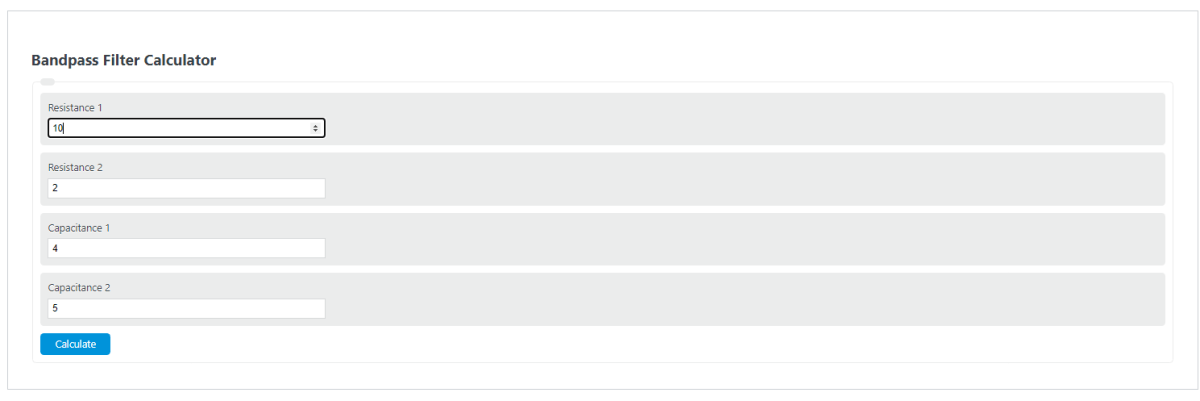Enter the two resistances R1 and R2 and the two capacitance’s C1 and C2 into the calculator to determine the cutoff frequency of the bandpass filter.
- Cutoff Frequency Calculator
- High Pass Filter Calculator
- Oscillator Frequency (RC) Calculator
- Impedance PCB Calculator
- SIW Calculator
Bandpass Filter Formula
The following formula is used to calculate the cutoff frequencies of a bandpass filter.
LCF = 1/2*pi*R2*C2
HCF = 1/2*pi*R1*C1
- Where LCF is the lower cutoff frequency (hz)
- HCG is the high cutoff frequency (hz)
- R1 and R2 are the resitances in a passive bandpass filter
- C1 and C2 are the capacitances in a passive bandpass filter
What is a Bandpass Filter?
A Bandpass Filter is an electronic circuit that allows a specific range of frequencies to pass through while attenuating or blocking frequencies outside of this range. It combines the properties of two other filters: the low-pass filter, which allows low-frequency signals to pass through, and the high-pass filter, which allows high-frequency signals to pass through.
The importance of a Bandpass Filter lies in its ability to selectively filter out unwanted frequencies and isolate the desired frequency range. By doing so, it enhances the clarity and quality of signals in various applications.
For instance, in audio systems, a Bandpass Filter can eliminate noise and interference, ensuring that only the desired range of frequencies, such as vocals or instruments, is reproduced. This results in improved sound fidelity and a better listening experience.
Bandpass Filters are also crucial in communication systems. They enable the transmission and reception of signals within specific frequency bands, allowing for efficient utilization of available bandwidth.
By blocking out unwanted frequencies, they help to reduce interference from other signals, enhancing the reliability and accuracy of data transmission. This is particularly important in wireless communication, where multiple devices operate simultaneously within the same spectrum.
Example Problem
How to calculate the cutoff frequencies of a bandpass filter?
First, deter the resistance and capacitance of C1 and R1. These should be as depicted below in the circuit.
For this example, the first capacitances and resistances are 10 farads and 4 ohms respectively. Keep in mind these may not be realistic for real-world bandpass filters but can be used to show the calculations more simply.
Next, determine the second capacitance and resistance. In this case, these values are found to the 5 farads and 2 ohms respectively.
Finally, calculate the lower and upper cutoff frequencies.
LCF = 1/2*pi*R2*C2
= 1/(2*3.14159*5*2)
= .0159 hz
HCF = 1/2*pi*R1*C1
= 1/(2*3.14159*10*4)
= .00397 hz.
FAQ
What are the components of a bandpass filter?
A bandpass filter typically consists of resistors and capacitors. The resistors (R1 and R2) and capacitors (C1 and C2) work together to define the lower and upper cutoff frequencies of the filter, allowing it to pass a specific range of frequencies while blocking others.
How do cutoff frequencies affect a bandpass filter’s performance?
The cutoff frequencies, defined as the lower cutoff frequency (LCF) and the higher cutoff frequency (HCF), determine the range of frequencies that the bandpass filter allows through. Frequencies outside this range are significantly attenuated, affecting the filter’s ability to isolate and pass the desired signal range effectively.
Can bandpass filters be used in digital signal processing?
Yes, bandpass filters are not only used in analog circuits but also in digital signal processing (DSP). In DSP, they are implemented through algorithms to process digital signals, allowing specific frequency components to be isolated or removed according to the filter’s design.
Why are bandpass filters important in communication systems?
Bandpass filters play a crucial role in communication systems by enabling the transmission and reception of signals within specific frequency bands. This helps in efficient bandwidth utilization and reduces interference from other signals, thereby enhancing the reliability and quality of data transmission in both wired and wireless communication systems.
